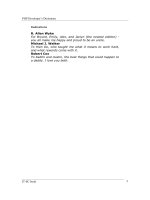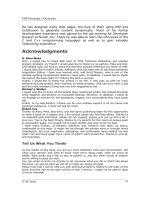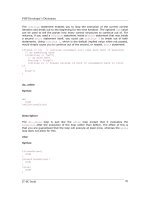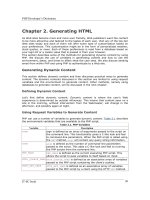PHP Developer''''s Dictionary- P3 pot
Bạn đang xem bản rút gọn của tài liệu. Xem và tải ngay bản đầy đủ của tài liệu tại đây (378.63 KB, 5 trang )
PHP Developer’s Dictionary
IT-SC book
10
He has designed many Web pages, the bulk of them using PHP and
ColdFusion to generate content dynamically. Much of his formal
development experience was gained on the job working for Developer
Support at Novell, Inc. There he was able to learn the intricacies of the
C and C++ programming languages as well as to gain valuable
networking experience.
Acknowledgments
R. Allen Wyke
First, I would like to thank Bob Kern of TIPS Technical Publishing—yet another
project complete, my friend! I would also like to thank my co-authors, Mike and Rob,
who helped push me hard to make this the best possible reference out there on PHP.
I would also like to thank Shelley Johnston, who has been one of the most wonderful
Acquisition Editors I have ever worked with, and Scott Meyers, who is one of the
hardest-working Development Editors I have seen. In addition, I would like to thank
the rest of the Sams team for making this book a success.
Finally, I would like to thank the woman in my life, J, who puts up with my crazy
schedule and personality when working on these projects. She has truly been a gift
and the most wonderful thing that has ever happened to me.
Michael J. Walker
I would also like to thank all the people Allen mentioned earlier who helped this book
come together and become an invaluable desktop reference. In addition, I thank all
my Engage co-workers for the assistance, respect, and camaraderie they have given
me.
Finally, to my wife Kendra, I thank you for your endless support in all my career and
personal endeavors. I could not ask for more.
Robert Cox
Thanks to Allen, Mike, Bob Kern, and the Sams publishing team for this opportunity
to write a book on a subject that I am excited about and find fascinating. Thanks to
my beautiful wife and friend, Sheila, for her support. Honey, you put up with a lot. I
love you. You're the best! Finally, thanks to my parents for the vision to always push
to accomplish goals. You taught me to reach stretch and work to be my best.
I have many friends, co-workers, teachers, and mentors who have, by proxy,
contributed to this book. It might not be through the printed word or through direct
contribution, but your inspiration, dedication, and enthusiasm have molded me into
what I am and have given me a vision of what I want to become. Thanks to you all,
and God bless.
Tell Us What You Think!
As the reader of this book,
you
are our most important critic and commentator. We
value your opinion and want to know what we're doing right, what we could do
better, what areas you'd like to see us publish in, and any other words of wisdom
you're willing to pass our way.
You can email or write me directly to let me know what you did or didn't like about
this book—as well as what we can do to make our books stronger.
Please note that I cannot help you with technical problems related to the topic of this
book, and that due to the high volume of mail I receive, I might not be able to reply
to every message.
PHP Developer’s Dictionary
IT-SC book
11
When you write, please be sure to include this book's title and author as well as your
name and phone or fax number. I will carefully review your comments and share
them with the author and editors who worked on the book.
Fax:
317-581-4770
E-mail:
Mail:
Mark Taber
Associate Publisher
Sams Publishing
201 West 103rd Street
Indianapolis, IN 46290 USA
PHP Developer’s Dictionary
IT-SC book
12
Introduction
Welcome to the
PHP Developer's Dictionary
. We hope that you will find this book the
most useful PHP reference available today. This is truly the type of book that should
be open next to your workstation, except for those of you who have obtained expert
PHP programming status. Even the best of us need to double-check code syntax
every once in awhile.
Within the pages of this book you will find a quick introduction to the language and a
complete reference to the PHP4 language. As a developer, you might often find
yourself scrambling for the correct syntax for a function or maybe some clarification
on how something works, and this book intends to fill that void.
Who Should Buy This Book?
Because this is a developer's dictionary, you will not find an in-depth tutorial on the
PHP language or complete project code for an application. What you will find is a
starter introduction to the language and a complete reference. Because of this, the
book is targeted to current PHP developers—developers who need a complete
reference of the newest version of the PHP language to keep with them as they
program.
Organization of the Chapters
The book is broken into two primary sections. The first, Chapters 1–3, is a brief
introduction to the language, and the remaining ten chapters act as a reference.
For those of you who have been programming in PHP for only a short while, you will
find that the first section gives you a good understanding of what can be
accomplished with PHP and how you might go about it. The rest of you will find an
introduction to many topics that you might not have known fall within the PHP
domain. This portion of the book will get your mind thinking about how you can
exploit these powerful concepts in today's applications.
The second section of the book is pure reference. We have tried to group all the PHP
functions and language elements in an easy-to-understand and easy-to-access way,
for you, the developer. Because the PHP language is always growing and adding new
functions, we also tried to organize it in a manner similar to the official
documentation so that you can quickly check online for any new additions,
comments, or bug reports.
Writing Conventions
Like all books, we have used a few writing conventions. These are items that you will
see throughout the book, and understanding what they mean will better help you use
the book. These conventions are as follows:
• Inline Syntax— Because this is a book about a programming language,
there will be times that we reference language elements or functions in the
body of a paragraph. We have used a special monospaced font to signify that
these are part of the PHP language. Here is an example:
PHP Developer’s Dictionary
IT-SC book
13
"You can use the
phpinfo()
function to…"
• Italics— Within a programming book, there are also instances where we
need to specify parameters or variables. These are not language elements,
but placeholders for where you will plug in the appropriate values. For this,
we will put the placeholder in an italic monospaced font. For instance, we
might say
"The
header()
function takes a header_directive as its only argument,
which…"
• Notes, Tips, Warnings— There are many times that we need to give you
more information or advice on a topic, but it doesn't really warrant an entire
paragraph. So, you will find Notes, Tips, and Warnings interlaced within the
chapters to give you a heads up on problem areas, or maybe a URL for an
online resource.
In addition to these structural elements of the book, you will see other conventions
used in the reference section. Primarily based around the organization of the entries,
and to help ensure that you get what you need out of the reference, the entries will
have the following:
• Entry Name—
Each entry in the book will begin with the entry's name.
These are organized by topic, subtopic, and then alphabetical. Because the
PHP programming language is so rich, there are instances of sub-subtopics,
but this should be fairly self-explanatory.
• Syntax—
After the entry's name you will see a brief syntax definition. This
will include the actual syntax that should be used when calling the function,
as well as the return type of the function. If there are any parameters passed,
the definition will point out the data types of the parameters.
• Description—
The final element in each entry is a description of what it
does. Within this area we will provide more information about the parameters,
let you know if the element is new to version 4 of PHP, and provide short
code examples when needed.
And that is all we are going to say. Like yourself, we are developers and small talk
does nothing but consume time. We appreciate that you took the time to read the
Introduction, and now we will return the favor by wishing you well on your use of the
PHP Developer's Dictionary.
R. Allen Wyke
Michael J. Walker
Robert Cox
PHP Developer’s Dictionary
IT-SC book
14
Chapter 1. Basic PHP
Background and History
In 1994, Rasmus Lerdorf created the predecessor to what has evolved into one of
the fastest-growing server-side scripting languages. PHP started as a set of tools that
Rasmus used to track users on his personal Web page. In the spring of 1995,
Personal Home Page Tools version 1 was introduced. It contained limited server-
side–parsed macros and simple utilities such as a guest book and a hit counter. Later
that same year, the parser engine was completely rewritten and released as PHP/FI
version 2. This version contained a form interpreter and native mSQL database
support.
In 1997, PHP took a huge step forward. The parser was completely rewritten by a
team of developers led by Zeev Suraski and Andi Gutmans. This parser formed the
foundation for version 3 of PHP. The success of PHP is difficult to gauge, but it has
been estimated that there are more than 1 million Web sites using PHP and that
number is increasing every month. PHP user groups have sprung up all over the
globe, many of them swearing allegiance to PHP and predicting the demise of
Microsoft's Active Server Pages. Much of this fervor is due to the excitement of PHP's
open source policy. The software and source code are available free on the Internet.
Price is not the only factor driving the popularity of PHP. Flexibility, extensibility, and
performance are key elements in the success of PHP. Much of the syntax used in PHP
was borrowed from C, Perl, and Java. Individuals with basic training in any these
languages can pick up PHP's syntax with very little effort. This inherent familiarity
also contributes to PHP's increasing popularity.
The current main PHP team includes developers from all over the world. Zeev
Suraski and Andi Gutmans are in Israel, Shane Caraveo resides in Florida, Stig
Bakken is from Norway, Andrei Zmievski is in Nebraska, Sascha Schumann and Thies
C. Arntzen are from Germany, Jim Winstead is from Los Angeles, and the father of
PHP, Rasmus Lerdorf, resides in North Carolina. Because of PHP's open source, many
developers and hobbyists contribute to the PHP's code. The contributions from this
unpaid group of experts add to PHP's popularity and its spectacular feature set.
PHP version 4 is currently in beta and includes many optimizations and feature
improvements. These improvements include a compiler, enabling code to run
significantly faster. There is support for caching compiled code, a code optimizer, and
a formal debugger. PHP 4 also includes better object-oriented syntax, self-contained
extensions, and a thread-safe core.
Advantages of PHP 4
PHP has two main competitors: Microsoft's Active Server Pages and Allaire's
ColdFusion. PHP has many advantages over these commercial packages. As
mentioned previously, one of the main advantages PHP has over ASP and ColdFusion
is its price. PHP is completely free and is available for download at hundreds of
mirror sites all over the globe. For many, this advantage is the deciding factor;
however, there are many more technical reasons to use PHP. PHP has the capability
to run on NT and UNIX. It is just as easy to build complex Web sites that run on
either platform. This cross-platform compatibility makes the transition from NT to
UNIX an easy proposition. Before PHP, converting Web code meant that changing a
server operating system was an extremely painful task. Operating-system









